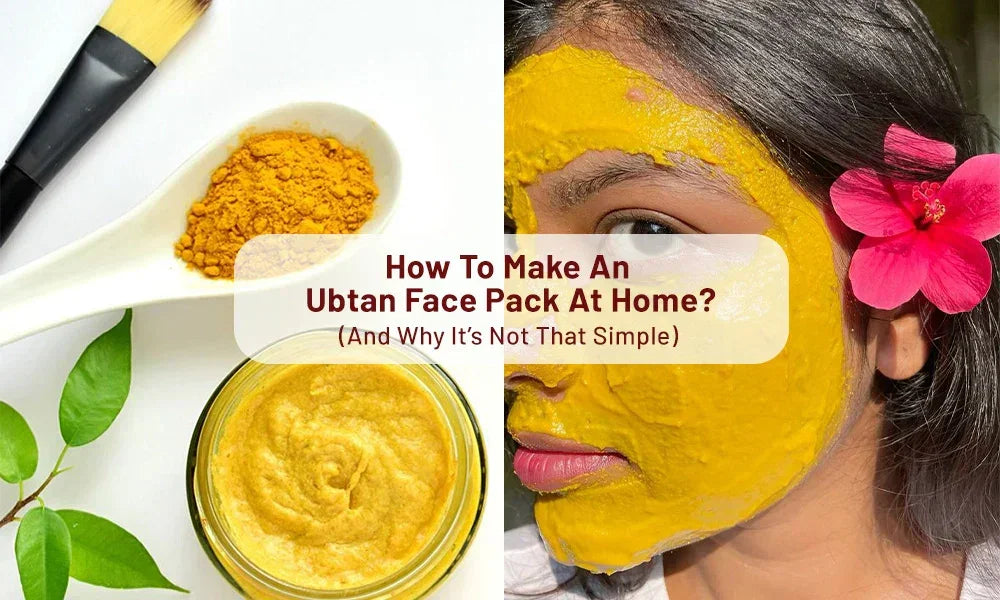
How To Make An Ubtan Face Pack At Home? (And Why It’s Not That Simple)
Table of Contents
In the past recent years, a lot of people have started leaning towards natural beauty. Now they want to stay away from synthetic chemicals of questionable origin, so anything tried-and-tested from nature becomes their option. One of the oldest, cherished skincare ritual traditions Ubtan is an herbal face pack that has been used since time immemorial to treat various skin concerns like whitening, cleansing, and rejuvenation. And so, the natural next question: Can we prepare Ubtan face packs at home?
Short answer: Yes-to some extent. You can always make a very basic version of an Ubtan. You cannot recreate the original Ayurvedic Ubtan at home! Here is why.
What is Ubtan?
Ubtan is partly a mixture of powders derived from natural substances and other Ayurvedic herbs and skin-beneficial agents. Poseidonically used in Indian weddings as a pre-wedding treatment for brides and grooms, it is much more than just a pack; it is an all-round beauty treatment.
A traditional Ubtan contains a carefully balanced mix of ingredients like:
Sandalwood
Turmeric
Multani Mitti (Fuller's Earth)
Rose petals
Kesar (saffron)
Vetiver
Manjistha
Neem
Lentils or chickpea flour
These ingredients are selected based on your prakriti (body constitution) in Ayurveda. Authentic Ubtan is often hand-pounded and prepared after soaking, sun-drying, and purifying herbs—something not easily done at home.
Why You Can’t Fully Make Ubtan at Home
While you can mix a few kitchen ingredients and call it “ubtan,” you’ll only get a simplified face pack—not the real thing. Here’s why:
Lack of Ayurvedic Processing
Most of the classical herbs for Ubtan are purified (shodhana), subjected to sun-drying, and cold-grinded - steps which are necessary to retain their effectiveness. These steps — which require time, technique and specialized knowledge that is tough to recreate in a kitchen — help concentrate flavors and create a just-right texture, but they’re also a reliable way to protect the food from spoilage by toxins produced by some low-acid bacteria, particularly in canned vegetables and pickles.
Use of Restricted Ingredients
Good quality saffron, wild turmeric (kasturi manjal) manjistha or pure sandalwood powder are not easily available in their purest form at local shops. When they are available, they tend to be adulterated with fillers.
Incorrect Proportions
The magic of Ubtan is in its equilibrium. There could be too much turmeric, which can stain the skin, or too much clay, which can dry it. Ayurvedic combinations are exact—A DYI one may not have the proper mixes in the correct dose for optimal results.
Home-made Ubtans don’t last long. Without natural preservatives or proper storage, they can spoil quickly or lose their effectiveness.
Can You Try a Basic Ubtan at Home?
If you're looking for a temporary glow or mild exfoliation, yes—you can make a basic herbal face pack using common ingredients:
Simple DIY Ubtan Face Pack Recipe:
Ingredients:
2 tbsp besan (gram flour)
½ tsp turmeric
1 tsp sandalwood powder (if available)
1 tbsp rose water or milk
A few drops of honey (optional)
Method:
Mix all the dry ingredients.
Then mix in rose water or milk to make a smooth paste.
It will easily go on face and neck.
Let it sit for 10–15 minutes.
Massage gently and remove with water.
This is certainly a fun little DIY treatment, but it’s not going to be able to provide the deep-cleansing, curative, long-term skin-health benefits that a real, herbally-enriched Ubtan can.
Why Should You Opt For Ready Ayurvedic Ubtan?
But if you really want to experience the real benefits of Ubtan— such as even skin and tone reduction, reducing tan, anti-inflammation, unclogging pores— invest in a well-formulated, ready-made one—it’s worth the investment. Here’s why:
Developed by professionals : Utilizes specific types of scarce herbs.
Clinically proven : safe and effective.
Ease of use : No mess, no prep time.
Consistency : Results may be evident with continued use.
Ensure the ubtan you are using is free from parabens, sulphates and synthetic fragrances and has authentic Ayurvedic processing.
Precautions to Be Taken When Applying Ubtan (DIY or Ready-made)
As with any product, you should always do a patch test if you have sensitive skin.
Just don’t rub too hard — that will irritate the skin.
Use 2–3x per week, not every day.
Do not add lemon juice if you’re going to go in the sun afterwards — it causes photosensitivity.
Conclusion
Ubtan is not only a face pack, it's a tradition based on Ayurveda. A DIY version might be a fun skincare ritual and all, but real Ubtan requires the wisdom of formulation, rare ingredients and authentic preparation techniques — not something you can find easily at home.
For authentic results, try a trusted Ayurvedic Ubtan brand that combines tradition with science. Because your skin is worth more than kitchen experiments.
FAQ
Can I make Ubtan at home with basic ingredients?
Yes, you can prepare a simple version using gram flour, turmeric, and milk. However, it won’t offer the full benefits of authentic Ubtan, which requires rare Ayurvedic herbs and traditional processing methods that are difficult to replicate at home.
What is the difference between DIY Ubtan and ready-made Ayurvedic Ubtan?
DIY Ubtan uses basic kitchen ingredients and offers temporary results. In contrast, a ready-made Ayurvedic Ubtan contains rare herbs like manjistha, kesar, and vetiver, processed using traditional techniques, offering deeper cleansing and long-term skin benefits.
How often should I use Ubtan on my face?
Ubtan is best used 2 to 3 times a week. Overuse may dry out the skin, especially if it contains clay or exfoliating agents. Always follow up with a light moisturizer.
Is Ubtan suitable for all skin types?
Generally, yes. Ubtan is gentle and natural, but it’s wise to do a patch test first, especially if you have sensitive or allergy-prone skin. Choose a formula based on your skin type—hydrating for dry skin, and oil-absorbing for oily skin.

